Understanding What is NEAR Protocol’s Blockchain Operating System (BOS)?

Near Protocol is a decentralized layer 1 blockchain platform with smart contract capabilities. At the beginning of 2023, NEAR introduced the blockchain operating system (BOS). Now, the NEAR ecosystem is supported by the BOS system, which provides a variety of solutions. In this article, we will discuss the reasons why NEAR introduced the BOS and what are the benefits of this operating system. Read more in this article.
Article Summary
- 🔧 The Blockchain Operating System (BOS) is a platform where development teams can build on top of any EVM network and write code in a familiar language.
- ✅ BOS has several notable features such as FastAuth, gateways, and censorship resistance. BOS NEAR provides convenience for developers, enterprises, and end users to enjoy the best experience when accessing the Web3 world.
- 👥 Since its launch in March 2023, the NEAR ecosystem has experienced remarkable growth and now boasts over 23 million accounts and thousands of projects in development.
What is a Blockchain Operating System (BOS)?
BOS is a technology that allows developers to create, deploy, and store frontends in a secure and decentralized manner, for use with any protocol and on any chain. Currently, BOS NEAR is compatible with the NEAR protocol and all EVM networks such as Ethereum, Arbitrum, and Polygon.
This novel approach leverages the unique capabilities of the NEAR runtime. In addition, data from different blockchains can be stored in reusable components that are accessible and auditable by anyone. All components running on BOS are fully composable, giving developers the freedom to combine, collaborate, and share code according to their specific needs and goals.
All components running on BOS are fully composable, giving developers the freedom to combine, collaborate and share code according to their specific needs and goals.
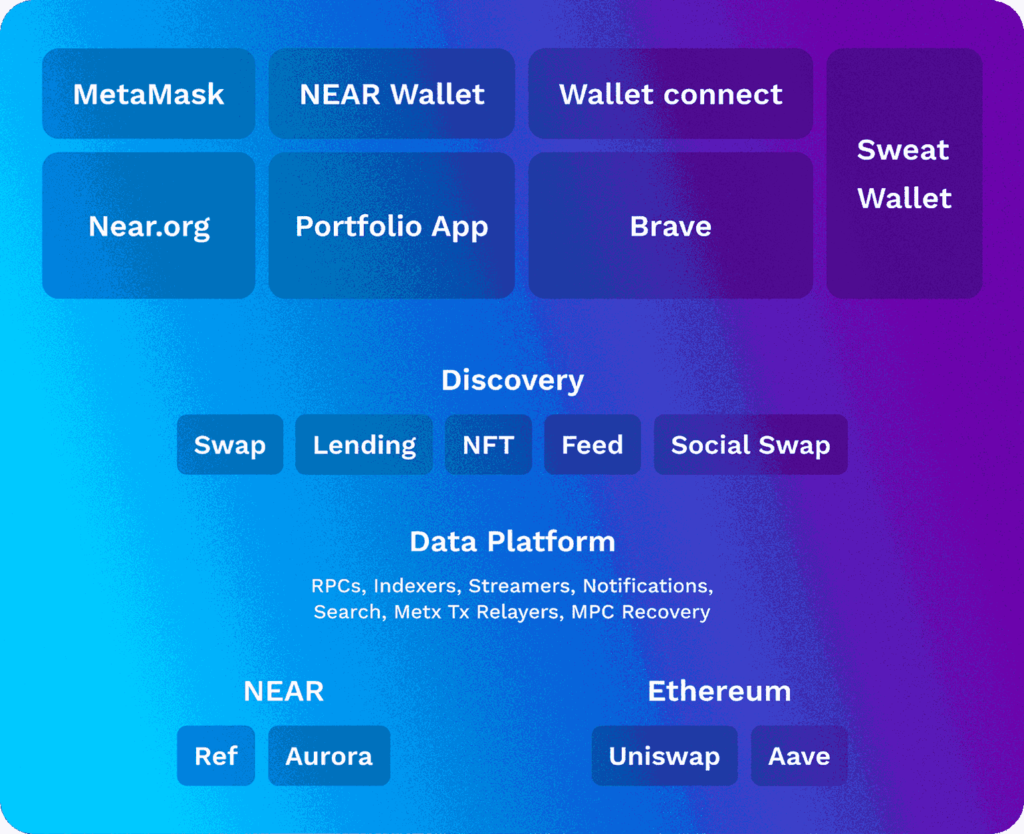
Reasons Behind NEAR’s Transition from Layer 1 to BOS
The launch of BOS has raised questions from users, developers, and investors within the NEAR community, particularly regarding the motivation behind this significant shift. Illia Polosukhin, co-founder of Near, provided clarity on this matter during the ETHDenver conference, “BOS is intended to act as a universal layer for exploring and discovering Web3 products, including cryptocurrency exchanges, non-fungible token (NFT) galleries, and social networks. The BOS framework is compatible with all blockchains that currently support the Near Protocol chain and the Ethereum Virtual Machine.”
Polosukhin also discussed how BOS provides a decentralized and composable front end for building and launching better applications, as well as faster forking. He believes that the BOS framework can work with both Web2 or Web3 backends and any wallet. In the future, Near also wants to provide the ability for users to use wallets from one chain to interact with another through a seamless connector.
How Does Blockchain Operating System Works?
BOS is built on three main pillars: Gateways, Components, & Blockchain.
Gateways
A gateway is a framework for creating decentralized frontends that run locally and are available to everyone. The gateway consists of a virtual machine that loads and runs frontends for protocols built on top of Ethereum, Layer 2, and other Layer 1 platforms such as NEAR. The code for these frontends is stored on the NEAR blockchain.
Therefore, anyone can create and run a gateway with different specializations. For example, near.org serves as an app store for dApps, near social focuses on social interactions between users, or developers can use bos.gg. There are many other specializations available, which you can check out at https://near.org/gateways.
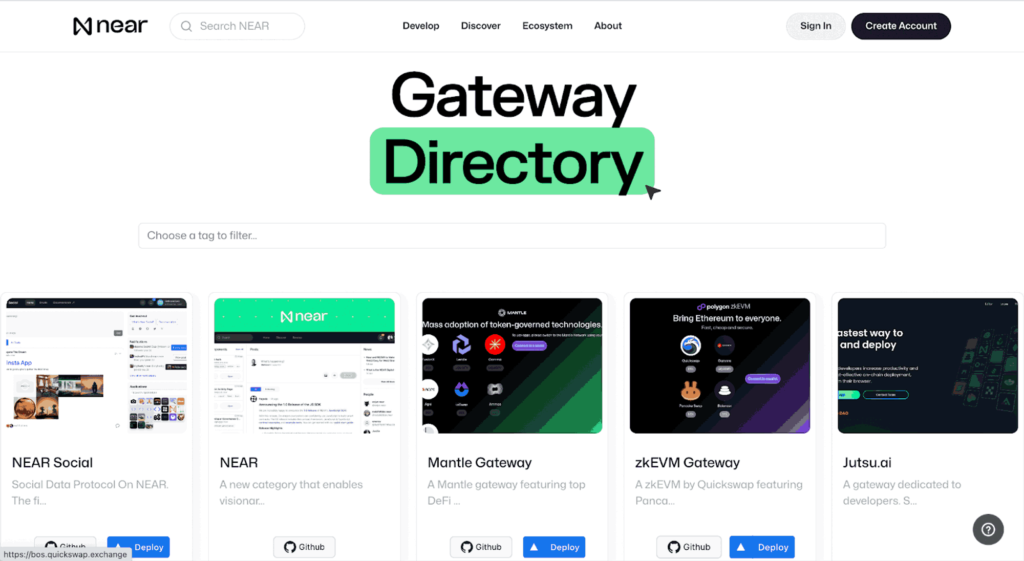
Components
Components serve as frontends for application layers and on-chain protocols such as Lido, Uniswap, and Aave. Developers have the ability to view the code for these applications through a gateway, much like one would view smart contracts on Etherscan.
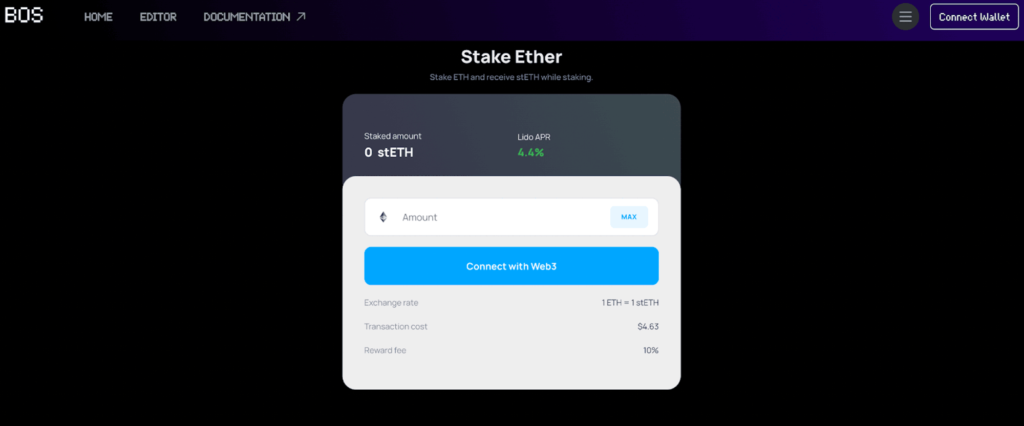
Developers can also fork different applications, use their own versions, or even create new components. For example, there are many components that display swap prices on different chains, all of which can be displayed side-by-side in a single comparison interface component. The creators of this component do not need to develop all the swap components, but can instead combine them into a “super application” component that they develop.
Blockchain
Finally, the pillar that works for BOS is blockchain. All applications using BOS can interact with any blockchain that is EVM compliant. This is possible because BOS is chain-agnostic (i.e. it is not tied to any specific blockchain). Therefore, BOS is compatible with all EVM chains. NEAR is used to store component code such as HTML, CSS, JavaScript and other data due to its low cost.
Advantages and Use-Cases of BOS
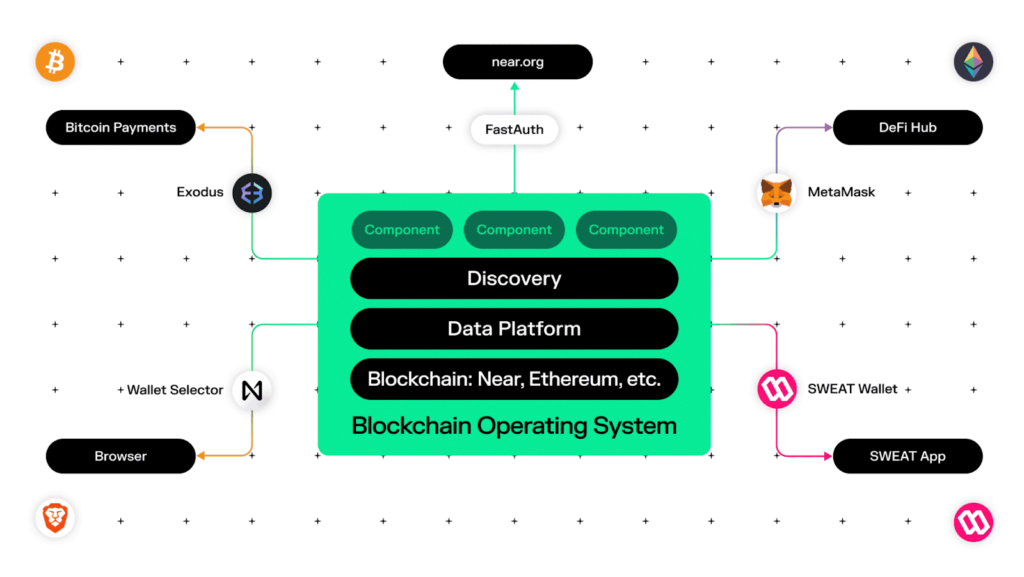
BOS has at least five major advantages and utilities aimed at overcoming several challenges associated with building front-ends for Web3 applications, including issues related to accessibility, security, compatibility, and time-to-market.
Decentralization and Security
The first point of discussion revolves around decentralization and increased security. With BOS, component code is permanently stored on the NEAR blockchain, ensuring transparency and easy accessibility. This enhances security and resilience, while providing robust uptime and access guarantees.
One of the case studies took place in August 2022 and involved a security breach that resulted in a significant theft at the leading dApp, Curve. The hackers exploited a vulnerability on Curve’s website, which redirected users to a malicious site and then performed a wallet drain.
In this case, the issue could have been avoided by using BOS and then performing on-chain interaction detection. As a result of the Curve incident, the importance of secure on-chain front-ends has gained attention.
Why can BOS prevent attacks like the above? Because the source code of BOS components can be validated on-chain or in-browser, such attacks can be detected earlier. Even when using a gateway that runs locally, the likelihood of such attacks is almost negligible.
Resistance to Censorship
Centralized cloud servers such as AWS or Google Cloud for front-end hosting have one aspect that contradicts the essence of decentralization, which is censorship. By using BOS, front-end components become more resistant to various forms of censorship and do not need to adhere to corporate policies like Amazon’s.
Open Source & Increased Flexibility
BOS also enables the development of front-ends that are public and adhere to open source principles. Developers can fork and modify the code within DeFi applications, making it accessible and usable across different applications through BOS.
For example, the Lido smart contract backend can now be accessed via a decentralized frontend using BOS. This opens the door for users to customize and enhance the user interface (UI), such as creating new components to enhance the UI of other dApps, or integrating graphs and analytics into the Lido UI. This is made much easier and faster by the availability of built-in features such as profiles, payments, notifications and search without the need to host anything.
Seamless Onboarding
BOS significantly lowers the entry barrier for new users in Web3 by facilitating registration via devices without requiring a seed phrase through Fast Auth. This simplification is crucial as an improved UI and User Experience (UX) can drive mass adoption in DeFi usage. Additionally, BOS aims to unify the Web3 landscape and encourage the creation of comprehensive applications including DEXs, money markets, NFT marketplaces, and more across various blockchains.
Ease for Developers
BOS simplifies front-end application development, enabling rapid prototyping without the hassle of infrastructure management. The platform encourages collaboration and code sharing among developers, promoting the creation of immutable components.
Those interested in learning more can visit near.org or near.social to explore various components and gateway experiences. For other gateways, you can browse the BOS Viewer Directory.
Developers also benefit from using BOS as it simplifies front-end application development, allowing for quick prototyping and building without the complications of infrastructure and server management. BOS fosters collaboration by providing a unified platform and facilitating code sharing among developers, allowing the option to relinquish ownership and create immutable components. With the use of JavaScript and ReactJS, developers can easily start their learning curve. For instance, a Lido component on BOS could be completed in just two hours. Developers interested can check out the BOS documentation at docs.bos.gg, as well as example components at bos.gg.
The Future of Blockchain Operating System
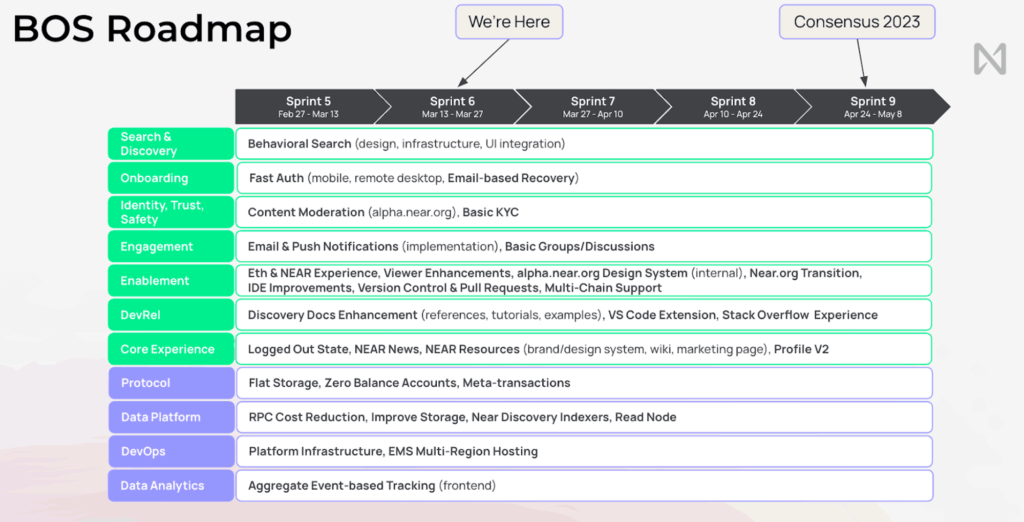
NEAR’s BOS continues to undergo various updates. With the presence of meta transactions and FastAuth, BOS is on the right track. The Web3 world is in dire need of a platform that can make it easier for many people to use. NEAR Protocol’s BOS is coming to simplify user interactions with dApps, widgets, and gateways while making life easier for development teams.
NEAR’s efforts through the BOS have led to tangible results: the NEAR ecosystem is thriving, with over 23 million accounts and hundreds of projects in development. The NEARcon event on November 7-10, 2023 is sure to bring a wealth of new updates and developments for the future of NEAR and the BOS platform.
Conclusion
Since the concept of BOS was first introduced in October 2022, a number of people were doubtful and even skeptical about the rebranding done by NEAR. Doubts even came from the Web3 community. However, almost a year after the system’s launch, it can be said that BOS offers unique competitive advantages and presents itself as a multi-faceted platform that will revolutionize the way we use open-source blockchain. BOS is a transformative concept that is more than just a “lite” client or an ordinary operating system. In short, BOS acts as a dynamic platform that includes:
dApps that use blockchain technology for various functions. Widgets, or easy-to-use plug-and-play components that add advanced functionality to dApps. Gateways designed for specific user groups that make blockchain technology accessible to a broader audience. BOS is an ever-growing ecosystem of widgets, dApps, and gateways that is driving the increased use of blockchain for a variety of applications, such as custodian providers, payment processors, oracles, indexers, storage solutions, DAO tools, NFT marketplaces, Play2Earn games, DeSci widgets, local AI, and IoT sensor networks.
Even in the long term, about a decade from now, NEAR aims to reach its first 1 billion users and become the one-stop shop for accessing the best use cases in the cryptocurrency world.
Also read: What is NEAR Protocol (NEAR)?
References
- Lyllah Ledesma, Near Protocol Starts ‘Blockchain Operating System’ to Focus on User Experience, Coindesk, accessed on 25 October 2023.
- Proximity, BOS: The World’s First Blockchain Operating System, Medium, accessed on 25 October 2023.
- Ashwin Kolhe, Blockchain Operating System (BOS) by NEAR Protocol, Linkedin, accessed on 25 October 2023.
- Sasha, NEAR BOS: NEAR Protocol’s Blockchain Operating System, Learnnear, accessed on 25 October 2023.
- Nearweek, INTRODUCING THE BLOCKCHAIN OPERATING SYSTEM (BOS), Medium, accessed on 25 October 2023.
Share
Related Article
See Assets in This Article
NEAR Price (24 Hours)
Market Capitalization
-
Global Volume (24 Hours)
-
Circulating Supply
-


